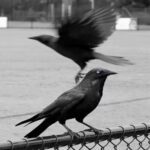Introduction Of Small Yellow Birds
Small yellow birds bring a burst of sunshine to the natural world with their vibrant plumage and cheerful presence. These diminutive avian wonders, often belonging to various species across the globe, captivate observers with their striking yellow feathers that symbolize joy, energy, and positivity.
Known for their melodious songs and agile flight, these small birds enhance the beauty of diverse ecosystems. From the American Goldfinch with its charming song, to the vibrant canaries that have graced households for centuries, and the exquisite Eurasian Siskin found in European forests, each species contributes its unique charm to the avian tapestry.
Small yellow birds, despite their size, play a significant role in their respective habitats. They aid in pollination as they flit from flower to flower, extracting nectar and inadvertently transferring pollen, thus fostering the growth of plants and flowers. Additionally, they are an essential part of the food chain, as their presence supports various predators and scavengers.
Whether spotted in urban parks, countryside meadows, or tropical rainforests, these birds evoke a sense of wonder and connection to nature. Their vibrant hues and cheerful demeanor serve as a reminder of the beauty and diversity that Mother Earth has to offer. Observing these small yellow birds can evoke feelings of tranquility and remind us of the simple joys that nature graciously provides.
1. American Goldfinch:

The American Goldfinch, a petite and charming songbird found across North America, is renowned for its vibrant yellow plumage and captivating musical abilities. In the warmer months, the males sport a brilliant lemon-yellow coat, while the females exhibit subtler hues. Their cheerful, warbling songs fill the air as they flutter among fields and gardens.
These finches are unique in their late breeding season, timed with the peak of plant seed production. Their beaks have evolved to adeptly extract seeds from various plants, making them true specialists in their diet. Their adaptable nature also allows them to thrive in a range of environments, from open meadows to urban settings.
The American Goldfinch’s enchanting presence and ecological contributions, such as aiding in pollination and insect control, make it a beloved fixture in North America’s avian landscape.
2. Yellow-Breasted Brush Finch:

The Yellow-Breasted Brush finch, a captivating bird native to the highland forests of South America, stands out for its striking appearance and distinctive behaviors. Sporting a vibrant yellow breast and belly, contrasting with its olive-green back, this finch’s coloration mirrors the lush landscapes it inhabits.
Measuring around 5.5 inches in length, this small passerine displays a charming blend of elegance and liveliness. Its melodious song resonates through the dense vegetation, adding an enchanting note to the natural chorus. The Yellow-Breasted Brush finch’s preferred habitat includes cloud forests and montane woodlands, where it forages for insects, seeds, and berries.
As an essential participant in its ecosystem, this brush finch assists in seed dispersal and insect control. Unfortunately, due to habitat loss and fragmentation, this species faces conservation concerns. Efforts to protect and restore its habitat are crucial in ensuring the survival of this captivating bird and preserving the delicate balance it contributes to the highland ecosystems of South America.
3. Western Kingbird:

The Western Kingbird (Tyrannus verticals) is a captivating small bird found in the western regions of North America. Recognizable by its sleek gray plumage and striking lemon-yellow underparts, this kingbird exudes a sense of elegance and vitality. Its distinctive white tail edges and bold white markings on its wings further distinguish it from other avian species.
Known for its assertive and vigilant behavior, the Western Kingbird is a skilled aerial predator, often seen perched on fence posts, treetops, or power lines, watching for insects and other small prey. With remarkable agility, it takes to the air to catch its quarry mid-flight, displaying its impressive hunting prowess.
This species is not just an adept hunter, but also an accomplished vocalist. Its call, a series of sharp, rapid notes, adds a musical element to its natural presence. Often found in open habitats like grasslands, farmlands, and open woodlands, the Western Kingbird showcases nature’s balance between beauty and functionality in the avian realm.
15 Amazing Facts About Raw Parrot
4. Black-Napped Oriole:

The Black-Napped Oriole (Oriolus chinensis) is a striking passerine bird known for its distinctive appearance and melodious calls. With a glossy black crown contrasting against vibrant yellow plumage, this bird’s visual appeal is undeniable. Native to parts of Asia, including India, Southeast Asia, and China, the Black-Napped Oriole inhabits a range of habitats, from forests to gardens.
Measuring around 25 centimeters in length, this medium-sized bird possesses a long tail and a slender, curved beak adapted for extracting nectar, fruits, and insects from various sources. Its enchanting song, composed of clear whistles and musical notes, fills its surroundings with a delightful serenade.
The Black-Napped Oriole is not only a delight to the eyes and ears but also an important agent in maintaining ecological balance. Its diet primarily includes insects and fruits, contributing to pest control and seed dispersal. As an integral part of many Asian ecosystems, the Black-Napped Oriole exemplifies the beauty and functionality that characterize avian diversity.
5. Yellowhammer:

The Yellowhammer (Emberiza citrinella) is a captivating small bird native to Europe and parts of Asia. Recognized for its striking yellow plumage, which gives it its name, the Yellowhammer is a symbol of the countryside’s vibrant vitality.
With its distinctive “little-bit-of-bread-and-no-cheese” song, the male Yellowhammer’s melodic calls resonate across open fields and grasslands during the breeding season. Its yellow feathers, streaked with brown and black, offer effective camouflage amidst rural landscapes.
This passerine bird plays a crucial role in maintaining insect populations and dispersing plant seeds, contributing to the ecosystem’s balance. However, the Yellowhammer faces challenges due to habitat loss and modern agricultural practices, which threaten its numbers.
Efforts to conserve the Yellowhammer include preserving its natural habitats and promoting sustainable farming practices that allow these birds to thrive. By cherishing the Yellowhammer, we not only celebrate the beauty of a small bird but also emphasize the importance of safeguarding biodiversity for the generations to come.
6. Yellow Cardinal:

The Yellow Cardinal (Gubernatrix cristata) is a striking bird species native to South America, particularly found in Argentina, Paraguay, Uruguay, and southern Brazil. Unlike its more common red relative, the Yellow Cardinal is known for its vibrant lemon-yellow plumage, which stands out against the greenery of its habitat. The males boast a prominent crest on their heads, adding to their distinctive appearance. These birds primarily inhabit open grasslands, scrublands, and savannas.
Yellow Cardinals are known for their melodious songs, which are often described as sweet and musical. They are usually found in pairs or small groups and are generally not migratory, preferring to remain in their preferred habitats year-round. Unfortunately, due to habitat loss and fragmentation, the population of Yellow Cardinals has been declining in recent years, making them a species of conservation concern. Conservation efforts are underway to protect their habitats and ensure the survival of this striking and unique bird species.
7. Yellow Warbler:

The Yellow Warbler (Setophaga petechia) is a small songbird that belongs to the New World warbler family. Its striking appearance features bright yellow plumage, often tinged with olive-green on the upperparts. Males and females exhibit similar coloration, although males may have slightly more vibrant markings during breeding season. These warblers are commonly found throughout North and Central America, often residing in habitats such as open woodlands, shrubby areas, and wetlands.
Renowned for their melodious and repetitive songs, Yellow Warblers are an auditory delight during the spring and summer months. Their diet primarily consists of insects and spiders, making them important contributors to pest control in their ecosystems.
During migration, many populations of Yellow Warblers undertake impressive journeys, traveling thousands of miles between their breeding grounds in North America and wintering habitats in Central and South America. Conservation efforts are important for these birds due to habitat loss and the potential impacts of climate change on their migration patterns and breeding success.
8. Female Summer Tanager:
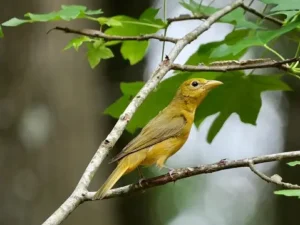
The female Summer Tanager (Piranga rubra) is a small, colorful songbird found primarily in North and Central America. It possesses a subdued yet striking appearance compared to its brilliantly red male counterpart. The female’s plumage is predominantly olive-yellow, allowing for effective camouflage during nesting and foraging activities. This coloration helps her blend into the surrounding foliage while she searches for insects and fruits, which constitute the majority of her diet.
While not as eye-catching as the male’s vibrant red plumage, the female’s subtle coloring provides her with essential protection from predators. During the breeding season, the female Summer Tanager constructs cup-shaped nests in trees, weaving together twigs, leaves, and other materials. Her mellow but sweet song often goes unnoticed among the livelier sounds of the forest, yet it remains an important part of the avian chorus.
The 20 Most Amazing Birds In Virginia! (2023)
9. Yellow-Headed Blackbird:

The Yellow-Headed Blackbird is a striking bird found in wetland habitats across North America, primarily in western regions. Its most distinctive feature is its bright yellow head and neck, contrasting with its black body. Adult males display a more intense yellow coloration during the breeding season, while females and juveniles have a duller appearance.
These blackbirds inhabit marshes, reed beds, and areas with tall vegetation near water sources, where they feed on insects, seeds, and aquatic plants. They are known for their unique and melodious calls, which include a mix of musical notes and harsh, grating sounds.
During the breeding season, males gather in colonies to establish territories and attract mates. They build cup-shaped nests among emergent vegetation, usually close to water. Conservation efforts have been focused on protecting wetland habitats, as these birds are considered a species of concern due to habitat loss and degradation.
Observing the Yellow-Headed Blackbird in its natural wetland environment is a rewarding experience for bird enthusiasts and nature lovers alike.
10. Golden Babbler:

The Golden Babbler (Cyanoderma chrysaeum), a small passerine bird, is native to the Indian subcontinent and Southeast Asia. Recognizable by its distinctive golden-yellow plumage, this bird resides in dense scrublands, forests, and grasslands. It is known for its energetic and sociable behavior, often found in groups of six to twelve individuals, engaging in constant chattering and movement.
The Golden Babbler primarily feeds on insects, foraging both on the ground and in shrubbery. Its well-coordinated group activities aid in locating food and avoiding predators. The species communicates through a variety of calls, using vocalizations to maintain group cohesion and signal danger.
These birds construct cup-shaped nests from grass, leaves, and twigs, usually hidden in thick vegetation. Breeding pairs share responsibilities, including incubation and feeding of their young. The Golden Babbler has adapted well to human-altered landscapes, demonstrating resilience in the face of habitat fragmentation. However, its survival is still threatened by habitat loss and other environmental challenges, necessitating conservation efforts to protect its unique and vibrant presence.
11. Cape Weaver:

The Cape Weaver (Ploceus capensis) is a small passerine bird native to southern Africa. Renowned for its intricate nest-building skills, the Cape Weaver constructs large, hanging nests made from grass and other plant materials. These nests are woven with precision, showcasing the male’s ability to create impressive structures to attract potential mates.
During breeding season, the males meticulously craft their nests, which can take several days to complete. Once the nest is ready, the male displays its weaving prowess to entice females. If a female is impressed, she will inspect the nest and might decide to line it with softer materials before laying her eggs.
These birds are often found in a variety of habitats, including grasslands, savannas, and suburban areas. The Cape Weaver’s striking yellow plumage, contrasted with darker markings, makes it a visually appealing species.
With its unique nesting behavior and vibrant appearance, the Cape Weaver stands as a fascinating example of avian ingenuity in the wild.
12. Village Weaver:

The Village Weaver (Ploceus cucullatus) is a small passerine bird found across sub-Saharan Africa. Known for its vibrant and intricate nest-building skills, this species displays remarkable breeding behavior. The male Village Weaver is particularly striking, with bright yellow plumage and a distinctive black face mask. During the breeding season, males construct intricate pendulous nests from grass, leaves, and twigs, often hanging them from the ends of tree branches. These nests serve as both shelter and a means to attract females.
The Village Weaver’s nesting colonies can be quite large, with dozens of nests hanging in close proximity. The male’s weaving prowess is a critical factor in attracting a mate, as females evaluate the quality of the nest construction. Once a pair forms, they collaborate on raising their offspring. Village Weavers primarily feed on seeds and insects, and their presence is often noted by their cheerful calls and active foraging behavior. These social birds bring a splash of color and activity to the African landscapes they inhabit.
Why Do Owls Hoot? How, When, And Where, 4 Amazing Facts
13. Prothonotary Warbler:

The Prothonotary Warbler (Protonotaria citrea) is a striking and vibrant songbird that resides in the eastern United States. Known for its bright golden-yellow plumage, this small warbler inhabits wetland areas such as swamps, marshes, and floodplains, often near slow-moving or still bodies of water. Its name is derived from the term “prothonotary,” referring to a clerical office that once used bright yellow robes.
During breeding season, the Prothonotary Warbler constructs its nest in tree cavities, usually near water, using plant materials and lining it with softer materials. They feed primarily on insects and small invertebrates, which they capture by hovering and gleaning from leaves and branches.
Despite their vibrant appearance, Prothonotary Warblers can be elusive due to their habitat preferences and quiet nature. Their populations are generally stable, but they face threats such as habitat loss and degradation. Conservation efforts often focus on protecting and restoring their wetland habitats, which are crucial for their survival. Birdwatchers and nature enthusiasts appreciate the chance to spot these dazzling birds in their natural habitats.
14. Saffron Finch Small Yellow Birds:

The Saffron Finch (Sicalis flaveola) is a small passerine bird native to South America. Known for its striking appearance, the male Saffron Finch boasts vibrant saffron-yellow plumage with black markings on its head, wings, and tail. Females, while less vibrant, still showcase a similar pattern. These birds are commonly found in open habitats like grasslands, savannas, and gardens across countries such as Brazil, Argentina, and Venezuela.
Saffron Finches are social and often seen in small flocks, foraging on seeds, fruits, and insects. Their melodious song is a delightful mix of trills and whistles. They are popular as pets due to their colorful appearance and cheerful vocalizations. In urban areas, they can adapt to feeding on bird feeders.
Their nesting habits vary, often building cup-shaped nests in trees or shrubs. The female usually lays a clutch of 3 to 4 eggs that hatch after about two weeks of incubation. As these finches thrive in various habitats, they are not considered threatened, but habitat loss and the exotic pet trade can impact their populations.
15. Yellow-Breasted Chat:

The Yellow-breasted Chat (Icteria virens) is a distinctive North American songbird known for its unique and complex vocalizations. This medium-sized bird is around 7 to 8 inches in length, with a bright yellow chest and a greenish-gray back. Despite its name, it is not closely related to true chats.
Found in dense shrubs, thickets, and woodland edges, the Yellow-breasted Chat is often elusive due to its secretive behavior. Its loud and varied songs are a medley of whistles, gurgles, and trills, often imitating the sounds of other bird species.
Primarily insectivorous, these chats also feed on fruits and berries during migration and winter. They build cup-shaped nests in dense vegetation, usually well hidden from predators.
Yellow-breasted Chats undertake long migrations, breeding in North America and wintering in Central America and parts of South America. Their unique appearance, secretive nature, and captivating vocalizations make them a sought-after sight and sound for birdwatchers and nature enthusiasts.
16. White-Eyed Vireo:

The White-eyed Vireo (Vireo griseous) is a small, colorful songbird found predominantly in the southeastern United States, Mexico, and Central America. Recognizable by its striking white iris, this vireo species displays a mix of olive-green and gray plumage on its back and wings, accompanied by a white underbelly. It is known for its vibrant, melodious song that consists of a variety of phrases and notes, often repeated in rapid succession.
White-eyed Vireos inhabit a range of habitats including dense shrubs, thickets, and brushy areas within woodlands, as well as along the edges of forests, making their homes at heights between 2 to 10 feet above the ground. Their diet primarily consists of insects, spiders, and berries. These birds are known for their active and curious behavior, often moving around the foliage in search of food.
Breeding season typically occurs during spring and summer, where they construct cup-shaped nests made of twigs, leaves, and grasses, often hidden within dense vegetation. Overall, the White-eyed Vireo contributes to the diversity of avian life with its unique appearance, distinctive song, and ecological role in controlling insect populations.
Why Are Birds So Loud In The Morning? 7 Surprising Reasons
17. Female American Redstart:
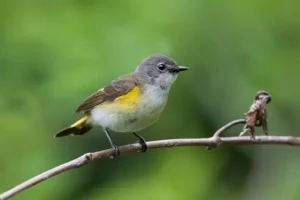
The female American Redstart (Setophaga ruticilla) is a small migratory songbird found in North America. With a distinctive appearance, this bird displays sexual dimorphism, differing from the male in coloration. The female redstart boasts a subtle yet elegant appearance, featuring grayish-olive plumage on the upperparts and a soft yellow hue on the underparts. Her wings and tail display white feather edges, adding a touch of brightness to her overall look.
While not as vividly colored as the male, the female redstart’s subtler palette serves her well as she forages for insects among the trees. She inhabits deciduous forests, particularly near streams and wet areas, where her insect-rich diet thrives. During nesting season, she constructs a cup-shaped nest in the lower branches, skillfully camouflaging it with her surroundings.
Despite her more muted tones, the female American Redstart is a crucial part of the species’ life cycle, contributing to its population’s survival through her nesting efforts and insect consumption.
18. Verdin Small Yellow Birds:
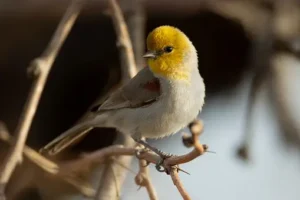
Verdin is a small, energetic songbird belonging to the family Remizid. It is primarily found in North and Central America, inhabiting open woodlands, scrublands, and grassy areas. The verdin is characterized by its vibrant yellowish-green plumage, tiny size, and distinctive nest-building behavior. These birds are known for their remarkable architectural skills and creating intricate hanging nests from plant fibers and other materials.
Verdins are highly social and often seen in small groups, foraging for insects, spiders, and nectar. They have a unique adaptation that allows them to extract nectar from flowers using their brush-tipped tongues. Their melodious calls and songs add a musical touch to their surroundings. These adaptable birds have managed to thrive in diverse habitats, from arid deserts to urban gardens. Verdins play an important role in pollination and insect control, making them valuable contributors to ecosystem health.
19. Magnolia Warbler Small Yellow Birds:
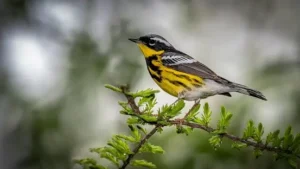
The Magnolia Warbler (Setophaga magnolia) is a strikingly colorful songbird that belongs to the New World warbler family. These small birds are known for their distinctive appearance, featuring vibrant yellow underparts with a bold black streak running through their eye and down their sides. Their upperparts are a mix of green and blue-gray, and they have a white belly. Magnolia Warblers breed primarily in the boreal forests of North America, including parts of Canada and the northeastern United States.
During their breeding season, they forage for insects among the trees and shrubs, often hovering to catch their prey mid-air. In the fall, they embark on an impressive migratory journey to their wintering grounds in Central America and the Caribbean.
The Magnolia Warbler’s beautiful appearance and its habit of frequenting gardens and wooded areas make it a sought-after bird for birdwatchers and nature enthusiasts. Protecting its breeding and migratory habitats is crucial to ensuring the continued survival of this charming and colorful species.
20. Yellow Canary:
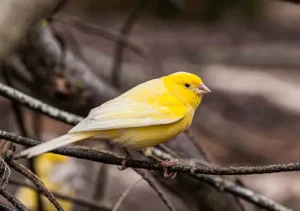
The Yellow Canary, scientifically known as Serious flaviventris, is a small songbird native to southern Africa. Its vibrant yellow plumage, especially in males, gives it its name. This species is popular for its melodious song and is often kept as a pet due to its charming appearance. Yellow Canaries are typically found in open habitats like grasslands, savannas, and scrublands. They primarily feed on seeds and insects, making them omnivorous.
In captivity, these canaries require spacious cages and a balanced diet to thrive. They are known for their ability to mimic sounds and tunes. Selective breeding has produced various color mutations, including variegated and orange variations. These captivating birds have become beloved companions and remain a symbol of beauty and joy in avian culture.
FAQ’s:
What inspired you to choose the title “Pretty Small Yellow Birds”?
This question delves into the origins of your title and explores what motivated you to select these particular words to represent your subject matter.
Are the “Pretty Small Yellow Birds” a specific species or a general reference to birds of that description?
This question seeks clarification on whether your title refers to a specific type of bird or if it’s a broader representation of birds with similar characteristics.
Can you provide more information about the significance of “Pretty Small Yellow Birds” in your work?
This question aims to understand the role these birds play in the context of your project, whether it’s a book, artwork, or any other creative endeavor.
How do the “Pretty Small Yellow Birds” relate to the themes or messages in your project?
This question explores the thematic connection between the title and the underlying concepts or messages you’re trying to convey through your work.
What techniques or mediums are you using to depict the “Pretty Small Yellow Birds”?
This question focuses on the creative process behind your work. It could encompass discussions about artistic techniques, writing styles, or other methods you’re employing to bring the “Pretty Small Yellow Birds” to life.
Must Visit: Vetpomedix.com
![20 Pretty Small Yellow Birds You Should Know [2023]](https://vetpomedix.com/wp-content/uploads/2023/08/20-Pretty-Small-Yellow-Birds-You-Should-Know-2023.jpg)
